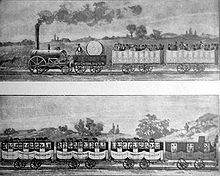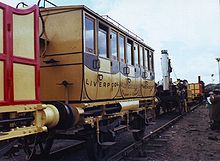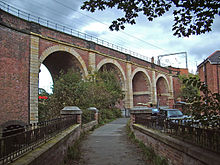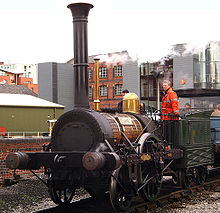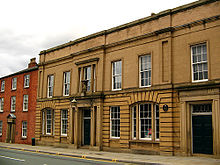- Liverpool and Manchester Railway
-
Liverpool and Manchester Railway 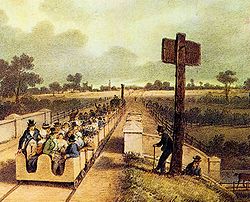
A painting of the inaugural journey of the Liverpool and Manchester Railway, by A.B. Clayton.Dates of operation 1830– Track gauge 4 ft 8 1⁄2 in (1,435 mm) (standard gauge) The Liverpool and Manchester Railway (L&MR) was the world's first inter-city passenger railway in which all the trains were timetabled and were hauled for most of the distance solely by steam locomotives. The line opened on 15 September 1830 and ran between the cities of Liverpool and Manchester in North West England in the United Kingdom.[1] The L&MR was primarily built to provide faster transport of raw materials and finished goods between the Port of Liverpool and mills in Manchester and surrounding towns. In 1845, the L&MR was absorbed by its principal business partner, the Grand Junction Railway (GJR); the following year the GJR formed part of the London and North Western Railway.
Contents
Historic line
Background to construction
The L&MR was intended to achieve cheap transport of raw materials and finished goods between the Port of Liverpool, and east Lancashire, in the port's hinterland. Huge tonnages of textile raw material were imported through Liverpool and carried to the textile mills near the Pennines where water and then steam power enabled the production of the finished cloth. The existing means of water transport, the Mersey and Irwell Navigation and the Bridgewater Canal, dated from the previous century, and were felt to be making excessive profits from the existing trade and throttling the growth of Manchester and other towns. (Similar feelings with regard to the railways led in turn to the construction of the Manchester Ship Canal in the 1890s). There was support for the railway from the cities at either end, but opposition from the landowners over whose land the railway was proposed to pass.
The original promoters are usually acknowledged to be Joseph Sandars, a rich Liverpool corn merchant, and John Kennedy, then owner of the largest spinning mill in Manchester. They were influenced to do this by William James.[2] Now something of a forgotten figure, James was a land surveyor who had made a fortune in property speculation. He advocated a national network of railways, based upon what he had seen of the development of colliery lines and locomotive technology in the north of England.
The Liverpool and Manchester Railway Company was founded on 24 May 1823. It was established by Henry Booth, who became its secretary and treasurer, along with other merchants from Liverpool and Manchester. A bill presented in 1825 to Parliament was rejected, but it passed in May the following year. In Liverpool 172 people took 1979 shares, in London 96 took 844, Manchester 15 with 124, 24 others with 286. The Marquess of Stafford had 1000, giving 308 shareholders with 4233 shares.
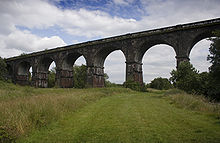 Stephenson's viaduct crosses the Sankey Brook, and the remains of the Sankey Canal. The viaduct is in use to this day.
Stephenson's viaduct crosses the Sankey Brook, and the remains of the Sankey Canal. The viaduct is in use to this day.
The initial survey for the line was carried out by William James and, being done surreptitiously and/or by trespass, was defective. Robert Stephenson departed for South America and William James became bankrupt. Consequently, in 1824 George Stephenson was appointed engineer in their place. By this time, he was taking on too much. As Robert was absent, George (who could not do the calculations required, and had relied on his son for this part of the business) left checking the survey to subordinates. Upon presentation to Parliament in 1825 it was shown to be inaccurate (particularly in relation to the Irwell bridge), and the first Bill was thrown out. A key opposition figure in this had been Robert Haldane Bradshaw, one of the trustees of the Marquess of Stafford's Worsley estate, which included the Bridgewater Canal.
In place of George Stephenson, who was now in disgrace, the railway promoters appointed George and John Rennie as engineers, who chose Charles Blacker Vignoles as their surveyor. They also set out to placate the canal interests and had the good fortune to be able to approach the Marquess directly through the good offices of their counsel, Mr. Adam, who was a relative of one of the trustees, and the support of William Huskisson who knew the Marquess personally. Implacable opposition to the line changed to financial support — a considerable coup.
The second Bill received the Royal Assent in 1826, and was for a railway on a considerably different alignment, avoiding the properties of particularly vociferous or effective opponents of the previous Bill, but as a consequence facing the challenge of crossing Chat Moss bog. It was intended to place the Manchester terminus on the Salford side of the river, but the Mersey and Irwell Navigation withdrew their opposition to a crossing of their river at the last moment, in return for access for their carts to the intended railway bridge. The Manchester station was thus fixed at Liverpool Road in the heart of Castlefield.
Construction
The terms asked for by the Rennies proving unacceptable, George Stephenson was reappointed as engineer with his assistant Joseph Locke. Previous experience with civil engineers set Stephenson against allowing Vignoles to continue his survey and he resigned. L. T. C. Rolt in his biography of Stephenson[3] suggests that a faction on the Board continued to ask Stephenson for second opinions, and Rennie took umbrage at this. Vignoles may have resigned because he had been appointed by Rennie, and as an ex-army engineer thought it the honourable thing to do.
The 35 miles (56 km) line was a remarkable engineering achievement for its time, beginning with the 2,250 yards (2,057 m) Wapping Tunnel beneath Liverpool from the south end of Liverpool Docks to Edge Hill. This was the world's first tunnel to be bored under a metropolis. Following this was a 2-mile (3.2 km)-long-cutting up to 70 feet (21.3 m) deep through rock at Olive Mount, and a nine arch viaduct (each arch of 50 feet (15.2 m) span), over the Sankey Brook valley, around 70 feet (21.3 m) high. Not least was the famous 4.75 miles (7.6 km) crossing of Chat Moss.
Having found it impossible to drain the bog, Stephenson began constructing a large number of wooden and heather hurdles, which were sunk into the bog using stones and earth until they could provide a solid foundation — it was reported that at one point tipping went on solidly for weeks until such a foundation had been created. To this day the track across Chat Moss floats on the hurdles that Stephenson's men laid and if one stands near the lineside one can feel the ground move as a train passes. It is worthy of note that the line now supports locomotives 25 times the weight of the Rocket, which hauled the first experimental train over the Moss in January 1830.
 The railway passes the Bridgewater Foundry at Patricroft, pictured in 1839
The railway passes the Bridgewater Foundry at Patricroft, pictured in 1839
The railway needed 64 bridges and viaducts, all of which were built of brick or masonry, with one exception: the Water Street bridge at the Manchester terminus. A cast iron beam girder bridge was used here to save headway in the street below the line. It was designed by William Fairbairn and Eaton Hodgkinson, and cast locally at their factory in Ancoats. It is important because cast iron girders became an important structural material for the growing rail network. Although Fairbairn tested the girders before installation, not all were so well designed, and there were many examples of catastrophic failure in the years to come, resulting in the Dee bridge disaster of 1847 and culminating in the Tay Bridge disaster of 1879.
The line was laid using 15 feet (4.57 m) fish-belly rails at 35 lb/yd (17.4 kg/m), laid either on stone blocks or, at Chat Moss, wooden sleepers.
Cable or locomotive haulage
For details of L&MR locomotives, see List of Liverpool and Manchester Railway locomotives.In 1829 adhesion-worked locomotives had not proved particularly reliable. The experience on the Stockton and Darlington Railway was well-publicised, and a section of the Hetton colliery railway had been converted to cable haulage. The success of the latter method was indisputable, while the steam locomotive was still untried. The L&MR had sought to de-emphasise the use of steam locomotives during the passage of the bill, the public having become alarmed at the idea of these monstrous machines which, if they did not explode, would fill the countryside with noxious fumes. Moreover, attention was turning towards steam road carriages, such as those of Goldsworthy Gurney's. There was thus a division in the L&MR board between those who supported Stephenson's "loco-motive" and those who favoured cable haulage, the latter supported by the opinion of the engineer, John Rastrick. Stephenson was not averse to cable haulage — he continued to build such lines where he felt it appropriate — but knew its main disadvantage, that any breakdown anywhere would paralyse the whole line.
The gradient profile of the line had been arranged so as to concentrate the steep grades in three places (either side of Rainhill at 1 in 100 and down to the docks at Liverpool at 1 in 50) and make the rest of the line very gently graded, say 1 in 2000. To determine whether and which locomotives would be suitable, the directors organised the Rainhill Trials. When the line opened the final passenger section from Edge Hill to Crown Street railway station was cable hauled as was the section down the Wapping Tunnel.
Double track
The line was built to 4 ft 8 1⁄2 in (1,435 mm) (standard gauge) and double track. Firstly, there was no convenient means of operating the line as single track as the line predated the telegraph. Secondly, the amount of traffic was expected to require double track.[citation needed]
A decision had to be made about how far apart the rails of the double track should be. It was decided to make the space between the separate tracks the same as the track gauge itself, so that it would be possible to operate over-gauge trains up the middle (there is no evidence of this having occurred).[citation needed] In later years, it was decided that the tracks were too close together, restricting the width of the trains, so the gap between tracks (track centres) were widened.[citation needed] The narrowness of this gap contributed to the first fatality, that of William Huskisson, and also made it dangerous to do maintenance work on one track while trains are operating on the other.[citation needed]
Opening
Main article: Opening of the Liverpool and Manchester RailwayThe line opened on 15 September 1830 with termini at Manchester, Liverpool Road (now part of the Museum of Science and Industry in Manchester) and Liverpool Crown Street. The festivities of the opening day were marred when William Huskisson, the popular Member of Parliament for Liverpool, was killed.
L.T.C. Rolt, in his biography of the Stephensons, describes the event in some detail. The Southern line was reserved for the special opening train, drawn by the locomotive Northumbrian and conveying the Duke of Wellington, then Prime Minister, in an ornamental carriage, together with distinguished guests in other carriages (including Huskisson). When the train stopped for water at Parkside, near Newton-le-Willows, it was intended that the other trains should pass in review on the Northern line. As the surface was covered with earth and cinders to rail level, it was easy for passengers to get down and stretch their legs, particularly as there was an interval between the delayed passing trains. Huskisson seized the opportunity to alight and stroll alongside the train. He then caught Wellington's eye through the Duke's carriage window. As the two were politically estranged, it was a golden opportunity to commence a reconciliation. The Duke inclined his head, someone opened the carriage door, and the two swapped pleasantries. Then, people noticed Rocket approaching on the Northern line and shouted a warning. The Austrian ambassador was bodily pulled into the carriage, but Huskisson panicked. He tried to climb into the carriage, but he gripped the open door, which swung back, causing him to lose his grip. He fell between the two tracks, but the 'Rocket ran over his leg which was fouling the rail, shattering it. He is said to have uttered the tragic words "I have met my death — God forgive me!"[4]
The Northumbrian was detached from the Duke's train and rushed him to Eccles, where he died in the vicarage.[4] Thus he became the world's first widely reported railway passenger fatality. The somewhat subdued party proceeded to Manchester, where, the Duke being deeply unpopular with the weavers and mill workers, they were given a lively reception (bricks thrown, etc.), and returned to Liverpool without alighting (a grand reception and banquet had been prepared for their arrival).
Notwithstanding the unfortunate start to its career, the L&MR was very successful. Within a few weeks of opening it ran its first excursion trains, carried the first railway mails in the world, and was conveying road-rail containers for Pickfords; by the summer of 1831 it was carrying tens of thousands by special trains to Newton Races.
Although the Act had allowed for it to be used by private carriers paying a toll, from the start the company decided to own and operate the trains itself. Although the original intention had been to carry goods, the canal companies reduced their prices, (an indication that, perhaps the railwaymen had been right to suggest their charges were excessive) and the extra transit time was acceptable in most cases. In fact the line did not start carrying goods until December, when the first of some more powerful engines, Planet, was delivered. What was not expected was the line's success in carrying passengers. The experience at Rainhill had shown that unprecedented speed could be achieved. The train was also cheaper and more comfortable than travel by road. So, at first, the company concentrated on this, a decision that had repercussions across the country and triggered the "railway mania".
Initially trains travelled at 17 miles per hour (27 km/h), due the limitations of the track. Drivers could, and did, travel more quickly, but they would be reprimanded: it was found that excessive speeds could force apart the light rails, which were set onto individual stone blocks without cross-ties. In 1837 work started to replace the original fish-belly rail with parallel rail of 50 pounds per yard (24.8 kg/m), on sleepers.[5]
The tunnel from Lime Street to Edge Hill was fully completed in 1836, and when it opened carriages were separated from their engines and lowered to Lime Street station by gravity, their descent controlled by brakemen, and hauled back up to Edge Hill by rope from a stationary engine. The tunnel is approximately 1,980 yards (1,811 m) long.
On 30 July 1842 work started to extend the line from Ordsall Lane to the new Manchester Victoria station. The extension was opened on 4 May 1844 and Liverpool Road station was thereafter used for goods traffic for over a century.
In 1845 the L&MR was absorbed by its principal business partner, the Grand Junction Railway (GJR); the following year the GJR formed part of the London and North Western Railway.
Influence
Being one of the first railways, many lessons had to be learnt from experience, but not many passengers were killed except by their own negligence.[citation needed] The L&MR developed the practice of red signals for stop, green for caution and white for clear, which spread by the early 1840s to other railways in Britain and the United States.[citation needed] These colours later changed to the more familiar red, yellow and green.[citation needed] The L&MR was also responsible for the gauge of 4 ft 8 1⁄2 in (1,435 mm), which came to be used more or less universally.[citation needed] The L&MR used left hand running on double track, following practice on British roads. The form of couplings using buffers, hooks and chains, and their dimensions, set the pattern for European practice and practice in many other places.
Modern line
Main article: Liverpool to Manchester LinesThe original Liverpool and Manchester line still operates as a secondary line between the two cities — the southern route, the former Cheshire Lines Committee route via Warrington Central is the busier route.
On the original route, an hourly fast service is operated by Northern Rail, from Liverpool to Manchester, usually calling at Wavertree Technology Park, St Helens Junction, Newton-le-Willows and Manchester Oxford Road, and continuing via Manchester Piccadilly station to Manchester Airport. Northern Rail also operates an hourly service calling at all stations from Liverpool Lime Street to Manchester Victoria. This is supplemented by an additional all-stations service between Liverpool and Earlestown, which continues to Warrington Bank Quay.
Between Warrington (Bank Quay), Earlestown and Manchester Piccadilly, there are additional services (at least one per hour) operated by Arriva Trains Wales, which originate from Chester and the North Wales Coast Line.
Electrification
In 2009, electrification at 25 kV AC was announced.
Stations
- Lime Street (work started on Edge Hill — Lime Street tunnel 23 May 1832; opened 15 August 1836).
- Crown Street (original Liverpool terminus, replaced by Lime Street).
- Edge Hill The first Edge Hill station was opened in 1830.[6] It was in the deep Cavendish Cutting at the heads of the Crown Street tunnel and the freight only Wapping Tunnel. After the Lime Street tunnel was bored in 1836, the original Edge Hill station was abandoned and relocated north, still inside the Edge Hill junction, to its present location at the head of the original Lime Street tunnel.[6] Edge Hill junction was the site of the locomotive works.
- Wavertree Technology Park (opened in 1990s)
- Broad Green
- Roby
- Huyton
- Whiston
- Rainhill
- Lea Green (closed in 1955 and re-opened with a completely new station in 2000)
- St Helens Junction (opened between 1833 and 1837; junction with the St Helens and Runcorn Gap Railway)
- Collins Green (closed 2 April 1951)
- Earlestown (built in 1831 by the Warrington and Newton Railway company; originally named Newton Junction; renamed after 1837)
- Newton-le-Willows (originally named Newton Bridge; renamed after Newton Junction was renamed Earlestown)
- Parkside (the line from Parkside to Wigan was opened on 3 September 1832[7])
- Kenyon Junction (built between 1833 and 1837; junction with the Bolton and Leigh Railway; closed 2 January 1961 and the Tyldesley Loopline; closed 5 May 1969)
- Glazebury & Bury Lane (closed 7 July 1958)
- Astley (closed 2 May 1956)
- Flow Moss Cottage (closed 1842)
- Lamb's Cottage (closed 1842)
- Barton Moss 1st (closed 1 May 1862)
- Barton Moss 2nd (closed 23 September 1929)
- Patricroft
- Eccles
- Weaste (closed 19 October 1942; site destroyed when M602 road built)
- Seedley (closed 2 January 1956; site destroyed when M602 road built)
- Cross Lane (closed 15 August 1949; site destroyed when M602 road built)
- Ordsall Lane (work on extension of line to Manchester Victoria started 30 July 1842 and the extension opened on 4 May 1844; station closed 4 February 1957)
- Liverpool Road (original Manchester terminus, closed 4 May 1844)
- Exchange Station (closed 5 May 1969)
- Victoria (opened in 1844)
(stations still open in bold)
See also
- L&M Lion 0-4-2
- List of Liverpool and Manchester Railway locomotives
Bibliography
- Booth, Henry (1830). An Account of the Liverpool and Manchester Railway. Reprint of the original edition by Frank Cass, 1969. ISBN 0-7146-1433-5
- Carlson, Robert E. (1969) The Liverpool and Manchester Railway project, 1821–1831. Newton Abbot: David and Charles. ISBN 0-7153-4646-6
- Donaghy, Thomas J. (1972) Liverpool and Manchester Railway operations, 1831–1845. Newton Abbot: David and Charles. ISBN 0-7153-5705-0
- Ferneyhough, Frank (1980.) Liverpool & Manchester Railway, 1830–1980. London: Robert Hale Ltd. ISBN 0-7091-8137-X
- Garfield, Simon (2002). The Last Journey of William Huskisson: the day the railway came of age. London: Faber. ISBN 0-571-21048-1
- Marshall, John (1969). The Lancashire & Yorkshire Railway, volume 1. Newton Abbot: David & Charles. ISBN 0-7153-4352-1.
- Ransom, P. J. G. (1990). The Victorian railway and how it evolved. London: Heinemann. ISBN 0-434-98083-8
- Thomas, R. H. G. (1980). The Liverpool & Manchester Railway. London: Batsford. ISBN 0-7134-0537-6
- Williams, Frederick S. (1833). Our Iron Roads.
References
- ^ The Stockton and Darlington Railway opened in 1825, but sections of this line employed cable haulage, and only the coal trains were hauled by locomotives. The Canterbury and Whitstable Railway, opened in May 1830, was also mostly cable hauled. Horse-drawn traffic, including passenger services, used the railway upon payment of a toll.
- ^ Macnair, Miles (2007). William James (1771–1837): the man who discovered George Stephenson. Oxford: Railway and Canal Historical Society. ISBN 978-0-901461-54-4.
- ^ Rolt L T C, George and Robert Stephenson, Longmans, London, 1960, ISBN 0-582-10745-8
- ^ a b Anon (21 September 1830). "Opening of the Liverpool and Manchester Railway: Melancholy accident to Mr. Huskisson (From a Manchester Paper)". The Hull Packet and Humber Mercury.
- ^ Morgan, Bryan (1971). Railways: Civil Engineering. London: Longman. ISBN 0-582-12792-0.
- ^ a b Biddle, Gordon (2003). "Liverpool". Britain's Historic Railway Buildings. Oxford, England: Oxford Universitgy Press. pp. 524–525. ISBN 978-0-19-866247-1.
- ^ Marshall 1969, p. 66
External links
Categories:- Grand Junction Railway
- Early British railway companies
- Rail transport in Liverpool
- Rail transport in Merseyside
- Rail transport in Lancashire
- Rail transport in Greater Manchester
- Railway companies established in 1823
- Railway lines opened in 1830
- Railway companies disestablished in 1845
- Standard gauge railways in England
Wikimedia Foundation. 2010.

